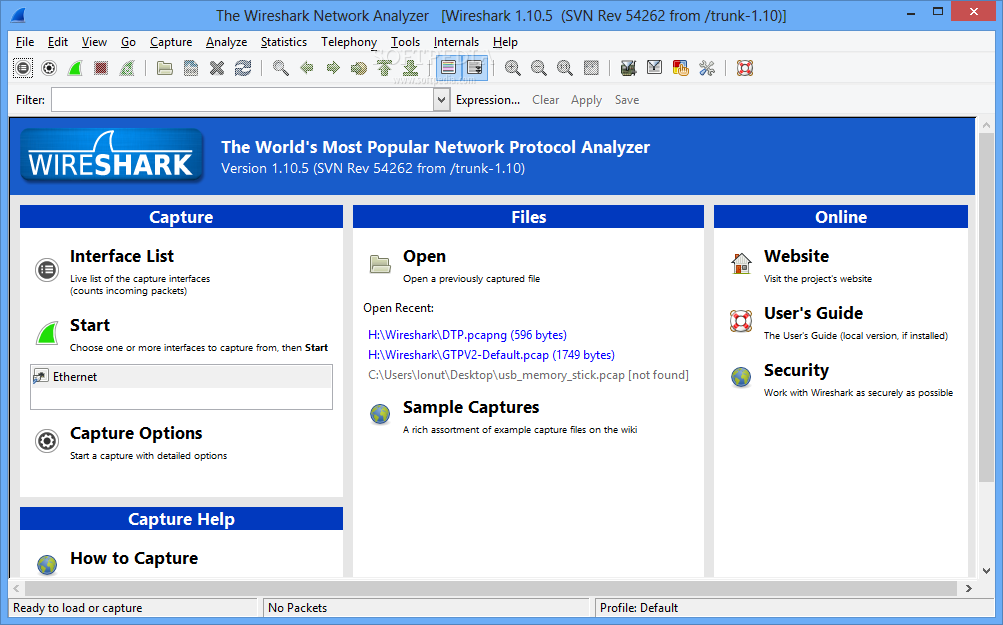

Keep in mind that captures from Meraki equipment aren't always going to display 100% of the packets that pass the device. Many times Wireshark can show the server admin that it is, in fact, NOT a network issue, but an issue where the server simply isn't responding to traffic that it's being sent. This guide is going to be diving into some (but not all) moderate to advanced Wireshark filters that can be used to help troubleshoot and narrow down the issue.
#Wireshark capture packets how to
For a quick rundown of how to get started, refer to the articles below. Meraki provides ample opportunity to gather data through packet capture.
#Wireshark capture packets free
Collaborating with other tools and frameworks to set up an all-in-one network monitoring solution.Network troubleshooting can be difficult and time-consuming to narrow down issues as they come up, and at some point, everyone will blame the network. One of the best tools that you can utilize is Wireshark, a free and open-source program.Handling capture files and issues related to their formats.Showing parameter specific statistics and insights.

Plugins are extra pieces of codes that can be embedded into the native Wireshark. Each protocol/port/other element is provided a unique color to make it easily visible for quick analysis. There is also a concept of coloring rules. The logical connective and or and not work here too.matches “parameter=value$” shows packets that are HTTP requests at the application layer level and their URI ends with a parameter with some value.tcp.port=80/udp.port=X shows the tcp/udp traffic at port X.These basic examples should provide a basic idea of their syntax: Another range of filters, display filters are used to create abstraction on captured data. There are some more basic filters and they can be combined very creatively. “and”, “not” and “or” logical connectives.(Used to combine multiple filters together).“port” can be prefixed with “src” or “dst” to indicate whether the data coming from or going to the target port. port (capture the traffic through or from a port).“net” can be prefixed with “src” or “dst” to indicate whether the data coming from or going to the target host(s).) net( capture the traffic through a network or sub-network).host (capture the traffic through a single target).As obvious a display level filter will not affect the packets being captured. Packets can be filtered based on many parameters like IP address, port number or protocol at capture level or at display level. Since there are a lot of packets going in and out every second, looking at all of them or searching for one type of packets will be tedious. The top pane shows source address(IPv4 or IPv6) destination address, source and destination ports, protocol to which the packet belongs to and additional information about the packet. The top pane shows real-time traffic, the middle one shows information about the chosen packet and the bottom pane shows the raw packet data. To start sniffing select one interface and click on the bluefin icon on the top left. This window shows the interfaces on your device. Getting Up and Running: After installation launch Wireshark, approve the administrator or superuser privileges and you will be presented with a window that looks like this: Currently, Wireshark uses NMAP’s Packet Capture library(called npcap). By default, Wireshark captures on-device data only, but it can capture almost all the data on its LAN if run in promiscuous mode. Wireshark captures the data coming or going through the NICs on its device by using an underlying packet capture library. Implementation of Bus Topology in Cisco.Implementing Star Topology using Cisco Packet Tracer.Convert comma separated string to array using JavaScript.Create a comma separated list from an array in JavaScript.How to create comma separated list from an array in PHP ?.Split a comma delimited string into an array in PHP.
#Wireshark capture packets update


 0 kommentar(er)
0 kommentar(er)
